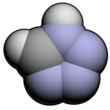Tetrazole
| |||
| Names | |||
|---|---|---|---|
| IUPAC name
1H-Tetrazole
| |||
| Identifiers | |||
3D model (JSmol)
|
|||
| ChEBI | |||
| ChemSpider | |||
| ECHA InfoCard | 100.005.477 | ||
PubChem CID
|
|||
CompTox Dashboard (EPA)
|
|||
| |||
| |||
| Properties | |||
| CH2N4 | |||
| Molar mass | 70.05 g/mol | ||
| Density | 1.477 g/mL | ||
| Melting point | 157 to 158 °C (315 to 316 °F; 430 to 431 K)[2] | ||
| Boiling point | 220 ± 23 °C (428 ± 41 °F; 493 ± 23 K) | ||
| Acidity (pKa) | 4.90 [1] | ||
Except where otherwise noted, data are given for materials in their standard state (at 25 °C [77 °F], 100 kPa).
| |||
Tetrazoles are a class of synthetic organic heterocyclic compound, consisting of a 5-member ring of four nitrogen atoms and one carbon atom. The simplest is tetrazole itself, CH2N4. They are unknown in nature.[citation needed]
Synthesis
Tetrazole was first prepared by the reaction of anhydrous hydrazoic acid and hydrogen cyanide under pressure. Treatment of organic nitriles with sodium azide in the presence of iodine or silica-supported sodium bisulfate as a heterogeneous catalyst enables an advantageous synthesis of 5-substituted 1H-tetrazoles. 2-Aryl-2H-tetrazoles are synthesized by a [3+2] cycloaddition reaction between an aryl diazonium and trimethylsilyldiazomethane.[3]
Uses
There are several pharmaceutical agents which are tetrazoles. The tetrazole ring can act as a bioisostere for the carboxylate group. Angiotensin II receptor blockers - such as losartan and candesartan, often are tetrazoles. A well-known tetrazole is dimethyl thiazolyl diphenyl tetrazolium bromide (MTT). This tetrazole is used in the MTT assay to quantify the respiratory activity of live cells culture, although it generally kills the cells in the process. Some tetrazoles can also be used in DNA assays.[4]
Some tetrazole derivatives with high energy have been investigated as high performance explosives as a replacement for TNT and also for use in high performance solid rocket propellant formulations.[5][6]
Other tetrazoles are used for their explosive or combustive properties, such as tetrazole itself and 5-aminotetrazole, which are sometimes used as a component of gas generators in automobile airbags. Tetrazole based energetic materials produce high-temperature, non-toxic reaction products such as water and nitrogen gas,[7] and have a high burn rate and relative stability,[8] all of which are desirable properties. The delocalization energy in tetrazole is 209 kJ/mol.
1H-Tetrazole and 5-(benzylthio)-1H-tetrazole (BTT) are widely used as acidic activators of the coupling reaction in oligonucleotide synthesis.[9]
Related heterocycles
- Triazoles, analogs with three nitrogen atoms
- Pentazole, the analog with five nitrogen atoms (strictly speaking, an inorganic homocycle, not a heterocycle)
- Oxatetrazole
- Thiatetrazole
References
- ^ Satchell, Jacqueline F.; Smith, Brian J. (2002). "Calculation of aqueous dissociation constants of 1,2,4-triazole and tetrazole: A comparison of solvation models". Phys. Chem. Chem. Phys. 4 (18): 4314–4318. Bibcode:2002PCCP....4.4314S. doi:10.1039/b203118c.
- ^ Mihina, Joseph S.; Herbst, Robert M. (1950). "The Reaction of Nitriles with Hydrazoic Acid: Synthesis of Monosubstituted Tetrazoles". J. Org. Chem. 15 (5): 1082–1092. doi:10.1021/jo01151a027.
- ^ Patouret, Remi; Kamenecka, Theodore M. (2016-04-06). "Synthesis of 2-aryl-2H-tetrazoles via a regioselective [3+2] cycloaddition reaction". Tetrahedron Letters. 57 (14): 1597–1599. doi:10.1016/j.tetlet.2016.02.102.
- ^ S Berner; K Mühlegger; H Seliger (Feb 11, 1989). "Studies on the role of tetrazole in the activation of phosphoramidites". Nucleic Acids Res. 17 (3): 853–864. doi:10.1093/nar/17.3.853. PMC 331708. PMID 2922273.
{{cite journal}}: Unknown parameter|last-author-amp=ignored (|name-list-style=suggested) (help) - ^ "Greener explosives show promise". Chemistry World. 2 October 2008.
- ^ Niko Fischer, Konstantin Karaghiosoff, Thomas M. Klapötke and Jörg Stierstorfer (April 2010). "New Energetic Materials featuring Tetrazoles and Nitramines – Synthesis, Characterization and Properties". Zeitschrift für anorganische und allgemeine Chemie. 636 (5): 735–749. doi:10.1002/zaac.200900521.
{{cite journal}}: CS1 maint: multiple names: authors list (link) - ^ Tore Brinck, Thomas M. Klapötke and Jörg Stierstorfer. "Energetic Tetrazole N -oxides". Green Energetic Materials: 133–178. doi:10.1002/9781118676448.ch06.
{{cite journal}}:|chapter=ignored (help) - ^ Nicholas Piekiel; Michael R. Zachariah (2012). "Decomposition of Aminotetrazole Based Energetic Materials under High Heating Rate Conditions". J. Phys. Chem. A. 116 (6): 1519–1526. doi:10.1021/jp203957t.
{{cite journal}}: Unknown parameter|lastauthoramp=ignored (|name-list-style=suggested) (help) - ^ Xia Wei (May 6, 2013). "Coupling activators for the oligonucleotide synthesis via phosphoramidite approach". Tetrahedron. 69 (18): 3615–3637. doi:10.1016/j.tet.2013.03.001.

